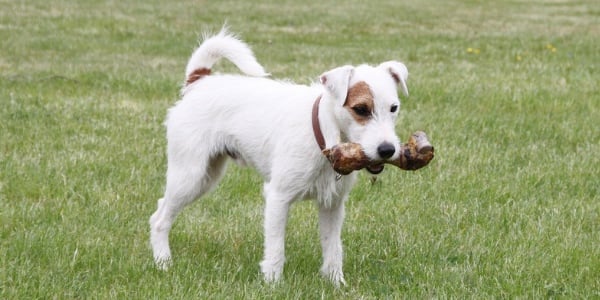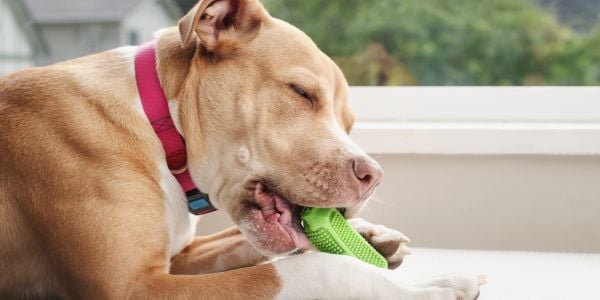
Any type of bone for a dog ….. is just dangerous.
I know, I know, there are dogs that have chewed on and consumed bones without any issue.
BUT did you know there were so many reported illnesses and deaths due to "bone treats" that the FDA issued a warning to pet owners? Here are the host of reasons put out in a bulletin by the FDA.
I understand every pet owner has their own opinion about bones. And that is perfectly fine.
But if your dog ever experiences the negative impact that bones can have, you likely will likely never give them another one.
Why Do People Think Bones Are Safe For Dogs?
Just like milk is synonymous with cats, bones have become synonymous with dogs. But why?
Dogs descended from an ancient unknown and extinct wolf population. These carnivorous animals had to hunt prey to survive. During certain seasons, the fat reservoir of the prey was poor. Therefore, they resorted to obtaining the last reservoir of fat, the bone marrow, to survive. This necessary behavior, bone-chewing, for survival needed to be pleasurable so it would survive throughout evolution. But domestication altered some of the anatomical factors that made this bone-chewing possible and easy.
The exact where, when, and how dogs were domesticated from wolves remains a debate, but it is believed the wolves followed humans around, consuming the rich resources (aka trash) they left behind. Over time, these wolves became tamer and less frightened of interactions with humans. People also realized that they benefited from the early warning system these wolves provided and their help on hunts. It was a mutually beneficial relationship, which has morphed over thousands of years into our current relationship with dogs today.
Because these wolves were eating a different food source and filling a different role in their environment, as they evolved into our domestic dogs, their physical characteristics changed. Their ears got floppier, their snouts got shorter, and their teeth got smaller and not as strong.
So now we have a dog that evolution has tricked into believing that bone-chewing gives great satisfaction, but domestication has changed them in a way that, anatomically, this activity isn’t safe.
Raw Bones Versus Cooked Bones
Despite the fact that there are some veterinarians who recommend raw bones, it is a myth that raw bones are OK, but cooked bones aren't.
Some Risks of Raw Bones
- Raw bones can be contaminated with E.coli, Listeria, and Salmonella species. Dogs may or may not be sickened by these pathogens, but they pose a significant human health risk, especially for children, the elderly, and immunocompromised individuals.
A study showed that Salmonella was isolated on 80% of the samples taken from BARF (Biologically Appropriate Raw Food or Bones and Raw Food) diet. It was also found in 30 % of the poop samples from dogs fed this type of diet as compared to none for dogs fed commercial dry diets. This poses a human health risk as well as the risk of environmental contamination. - Raw bones can be too hard, just like cooked bones. When bones are too hard, they can damage a dog’s teeth. Tooth fractures are not only painful for dogs, but they also require expensive dental evaluations and treatment.
- Raw bones still cause gastrointestinal upset, bone impaction (leading to obstruction), and intestinal perforation. The last two points are especially true if dogs are allowed to consume them in significant quantities or routinely.
- Raw bones can still pose a choking hazard, especially if cut into small pieces.
- If not stored correctly or eaten promptly, raw bones spoil in just a few days and can sicken dogs if eaten.
- Certain types of raw bones, such as pork rib bones, are high in fat. High-fat consumption can cause pancreatitis.
What About the Bones in a Raw Food Diet?
Bones in their ‘raw’ form are part of a raw food diet. All the same risks mentioned above apply to the bones in a raw food diet.
In addition to the dangers the bones can cause, the diet also increases the chances for nutritional deficiencies and exposure to harmful bacteria and parasites.
The FDA Center for Veterinary Medicine conducted a study that showed that raw pet food diets were more likely to be contaminated with disease-causing bacteria over other pet food diets. These results raise significant concerns with regard to public health risks.

Problems Vets See With Dogs Chewing or Eating Bones
There are plenty. This type of dog emergency is painful, distressing, and costly. Some are even fatal. There are some dangers that bones cause that may not be noticed immediately, as dogs are masters at hiding pain, and pet owners don’t always notice the subtle signs. As time passes, the situation can worsen.
Here’s a sample of the bone-chewing and eating problems commonly seen by veterinarians and experienced by dog owners:
Broken teeth: Painful for the dog and can lead to a tooth infection. Requires anesthesia and surgery to fix or remove the tooth.
Oral cavity injuries: The razor-sharp edges of a broken bone can cut or pierce a dog’s tongue, gums, cheek, or soft palate and cause infection. These sharp pieces can become lodged into areas of the mouth, such as between the teeth or into the soft palate on the roof of the mouth, that require surgery. Besides the removal of the bone, any damaged teeth must be removed as well. Oral surgeries of this nature are not only painful for a dog; they can be very costly.
Bones can entrap the lower jaw: Circular-shaped or round bones can get looped around the lower jaw, just behind the lower canine teeth. As you can imagine, this causes most dogs to panic and potentially harm themselves further. Unfortunately, this often requires your dog to be sedated by a veterinarian to have the bone cut off of their jaw.
Obstructed airway: Distressing for the dog and owner, as the dog has difficulty breathing. It requires quick action to remove the lodged bone. Sometimes attempts are unsuccessful, and plenty of dog owners have been bitten by their distressed dog while trying to remove the lodged bone at home.
Digestive irritation: Consumption of bones and fragments can lead to pain and inflammation of the lining of the stomach (gastritis) and/or intestines (enteritis). This often results in a refusal to eat, as well as vomiting and/or diarrhea (frequently with blood in it).
Constipation: Bone fragments can make it all the way through the small intestines only to collect in the colon and cause constipation. This causes dogs considerable discomfort, and it may require sedation in order to correct the situation.
Digestive obstruction: Blockage of the stomach and/or intestinal tract results in vomiting, abdominal pain, electrolyte imbalances, and dehydration. If obstructed long enough, the blood flow to that area of the digestive tract can become compromised, and the tissues can die off, resulting in spillage of gut contents into the abdominal cavity (peritonitis with or without sepsis). Anesthesia and an endoscopy, and/or surgery are typically required to remove an obstruction.
Digestive tract perforation: Sharp points on broken bones can poke through the wall of the stomach and/or intestines as they pass through, resulting in spillage of gut contents into the abdominal cavity (peritonitis). This is a very painful and debilitating condition, requiring surgery and intensive care to correct.
In addition to bones, there are many popular dog chews that are potentially dangerous, such as deer antlers, that I would not recommend. Find out which of the most popular chew toys are actually dangerous for dogs.

Non-Bone Safe Dog Chew Options
We all agree that chewing is a natural behavior for dogs that has benefits, including calming effects. The best thing to do is find safe alternative options to bones to satisfy that behavior and provide them the needed pleasure associated with it.
You may be wondering what safe chew options you can give your dog to not only provide your dog with all the advantages of chewing but also add some tooth-scraping benefits. Here are some options, all of which our team uses with their dogs:
West Paw Qwizl — Top Pick for Strong Chewers: The Qwizl is a tough chew toy that doubles as a treat holder, which means you can add a dental chew or squeeze some peanut butter into the center. It has a soft texture, which is safer for teeth, gums, and jaw muscles.
Whimzees Dog Dental Chews — Daily Teeth Cleaning Option: Whimzee chews are made with non-GMO ingredients and no artificial colors, flavors, preservatives, gluten, or meat. They're perfect for dogs with food allergies or sensitivities. They have a variety of sizes and shapes so that you can pick the best for your dog. Whimzees are approved by the Veterinary Oral Health Council (VOHC), which tests and verifies the claims of dental products for cats and dogs.
Virbac C.E.T. Enzymatic Rawhide Chews — Veterinarian Favorite: The formula makes them easier to digest and, just like the Whimzees above, accepted as a product by the Veterinary Oral Health Council (VOHC). ). Your dog’s breath will be fresh, and the plaque will be reduced due to the chew's dual-enzyme system. Virbac rawhides are one of our go-to's for rawhide chews, as not all rawhides are created equal.
Earth Animal No-Hide Chews — Our Favorite Rawhide Alternative: Perfect for those dogs that can’t have any rawhide chews, as well as those with more sensitive gastrointestinal tracts. With a variety of flavors and sizes, you have options if your dog has food allergies. You can add the Funnl for an extra challenge and chew time.
Virbac C.E.T. VEGGIEDENT Flex Tartar Control Chews for Dogs: These VOHC treats are not only a great chew option, but they also support oral, gut, and joint health. That’s way more benefits than a bone can provide!
Playology – This durable chicken, beef, and even sweet potato-scented dog bone is soft enough for teeth yet durable enough to withstand your dog's chewing. They have various sizes and "strengths" for puppies, senior dogs, and even heavy chewers.
There are many other dog chews and toys that your dog will love to chew on over a bone, and they help eliminate some costly risks. Believe me, the risk of bones FAR outweighs their benefits, especially since they can be fatal. As a veterinarian, I've seen and had to treat the damage they cause.



